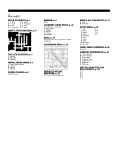<pubnumber> 735F03002
735F03002 </pubnumber>
<title>Backyard Activity Book for Kids on Intergrated Pest Management</title>
<pages>33</pages>
<pubyear>2003</pubyear>
<provider>NEPIS</provider>
<access>online</access>
<operator>mja</operator>
<scandate>11/13/08</scandate>
<origin>PDF</origin>
<type>single page tiff</type>
<keyword>insects pests http www kids eat plants page weeds agency protection environmental loosestrife united states pest tke gov soil disease</keyword>
<author> Minnesota. Dept. of Agriculture.</author>
<publisher>Minnesota Dept. of Agriculture,</publisher>
<subject> Pests--Integrated control--Study and teaching--Activity programs--Minnesota</subject>
<abstract></abstract>
•grams
(7506C)
:>* '-I
N--
A Backyard
Activity Bool
'or Kids
>n Integrated
Management
L3c*yfc/^
Beeft
^ f9/;
image:
</pubnumber>
<title>Backyard Activity Book for Kids on Intergrated Pest Management</title>
<pages>33</pages>
<pubyear>2003</pubyear>
<provider>NEPIS</provider>
<access>online</access>
<operator>mja</operator>
<scandate>11/13/08</scandate>
<origin>PDF</origin>
<type>single page tiff</type>
<keyword>insects pests http www kids eat plants page weeds agency protection environmental loosestrife united states pest tke gov soil disease</keyword>
<author> Minnesota. Dept. of Agriculture.</author>
<publisher>Minnesota Dept. of Agriculture,</publisher>
<subject> Pests--Integrated control--Study and teaching--Activity programs--Minnesota</subject>
<abstract></abstract>
•grams
(7506C)
:>* '-I
N--
A Backyard
Activity Bool
'or Kids
>n Integrated
Management
L3c*yfc/^
Beeft
^ f9/;
image:
 H
ave you ever been bitten by a flea or mosquito? Treated your dog for fleas? Had head lice? Been
stung by a wasp or bee? Watched weeds overtake your garden? Fought to cockroaches
out of your school building?
We've all been bugged at one time or another by pests. For many of us, our first reaction is to reach
for the nearest can of bug spray. But, pesticides and fertilizers that run off from lawns and other
locations are a significant source of pollution in our environment. There's a better way to solve
problems called Integrated Pest Management (IPM). IPM is an effective and environmentally sensitive
approach to management that relies on a combination of common practices. Teaching
IPM at the grade school level can provide children with important information about identity and
biology, and ecology. It can also help children understand the impact that personal choices — like
whether or not to use chemicals to control — can have on our environment.
Join Our Patrol: A Backyard Activity Book on Management, originally developed
by the Minnesota Department of Agriculture, is for educators of children in grades 1-6. Join Our Pest
Patrol is chock full of fun activities that can easily be incorporated into reading, science, and even
math and art classes. The activities are written for the 3-5 grade level, but can be easily adapted for
the lower or upper grades. Each activity includes fun facts in "Did You Know," and "Tips for Grown-
ups." There are also lots of links to interesting web that allow educators to expand their students'
learning. Answers to all quizzes are located at the end of the book inside the back cover. We've also
included a Web Resources List on 26 and 27 of all the web links identified in the activities for
easier reference.
We hope you enjoy Join Our Pest Patrol and invite you to tell us about how you've used this resource
by completing our Customer Feedback Form on page 28. Good luck, and thanks for your interest in
Integrated Pest Management!
EPA thanks the following people who contributed to the activity book:
MDA Project Team
Jeanne Ciborowski, IPM Coordinator, Minnesota Department of Agriculture (MDA); Rick Hansen, Unit Supervisor,
Agronomy and Plant Protection Division; Al Withers, Program Director, Minnesota Agriculture in the Classroom
Cooperators
Bob Mugaas, Extension Educator, University of Minnesota Extension Service, Hennepin County; Jeff Ledermann,
Education Specialist, Minnesota Office of Environmental Assistance; Julianne Jackels, Grade 3 Teacher, Oak Ridge
Elementary, Eagan, MN
Writing/Editing
Kathy Seikel, Jane Duden and Jan Hoppe
Design, Illustration, Production
Northern Design Group
U.S. EPA Project Coordinator
Katherine Seikel, Office of Pesticide Programs, Communication Services Branch
Adapted for nationwide audience by Abt Associates, Inc., and The COM Group, Inc., under contract with the U.S. EPA.
United Environmental Protection Agency
Office of Pesticide Programs
Field and External Affairs Division
Communication Services Branch
1200 Pennsylvania Avenue, N.W. (7506C)
Washington, D.C. 20460
http://www.epa.gov/pesticides/
(703)305-5017
image:
H
ave you ever been bitten by a flea or mosquito? Treated your dog for fleas? Had head lice? Been
stung by a wasp or bee? Watched weeds overtake your garden? Fought to cockroaches
out of your school building?
We've all been bugged at one time or another by pests. For many of us, our first reaction is to reach
for the nearest can of bug spray. But, pesticides and fertilizers that run off from lawns and other
locations are a significant source of pollution in our environment. There's a better way to solve
problems called Integrated Pest Management (IPM). IPM is an effective and environmentally sensitive
approach to management that relies on a combination of common practices. Teaching
IPM at the grade school level can provide children with important information about identity and
biology, and ecology. It can also help children understand the impact that personal choices — like
whether or not to use chemicals to control — can have on our environment.
Join Our Patrol: A Backyard Activity Book on Management, originally developed
by the Minnesota Department of Agriculture, is for educators of children in grades 1-6. Join Our Pest
Patrol is chock full of fun activities that can easily be incorporated into reading, science, and even
math and art classes. The activities are written for the 3-5 grade level, but can be easily adapted for
the lower or upper grades. Each activity includes fun facts in "Did You Know," and "Tips for Grown-
ups." There are also lots of links to interesting web that allow educators to expand their students'
learning. Answers to all quizzes are located at the end of the book inside the back cover. We've also
included a Web Resources List on 26 and 27 of all the web links identified in the activities for
easier reference.
We hope you enjoy Join Our Pest Patrol and invite you to tell us about how you've used this resource
by completing our Customer Feedback Form on page 28. Good luck, and thanks for your interest in
Integrated Pest Management!
EPA thanks the following people who contributed to the activity book:
MDA Project Team
Jeanne Ciborowski, IPM Coordinator, Minnesota Department of Agriculture (MDA); Rick Hansen, Unit Supervisor,
Agronomy and Plant Protection Division; Al Withers, Program Director, Minnesota Agriculture in the Classroom
Cooperators
Bob Mugaas, Extension Educator, University of Minnesota Extension Service, Hennepin County; Jeff Ledermann,
Education Specialist, Minnesota Office of Environmental Assistance; Julianne Jackels, Grade 3 Teacher, Oak Ridge
Elementary, Eagan, MN
Writing/Editing
Kathy Seikel, Jane Duden and Jan Hoppe
Design, Illustration, Production
Northern Design Group
U.S. EPA Project Coordinator
Katherine Seikel, Office of Pesticide Programs, Communication Services Branch
Adapted for nationwide audience by Abt Associates, Inc., and The COM Group, Inc., under contract with the U.S. EPA.
United Environmental Protection Agency
Office of Pesticide Programs
Field and External Affairs Division
Communication Services Branch
1200 Pennsylvania Avenue, N.W. (7506C)
Washington, D.C. 20460
http://www.epa.gov/pesticides/
(703)305-5017
image:
 a*cj Ack*ovulecjcjfie*t; .................................. Inside front cover
Table </ Co*te*t; [[[ Pages i-ii
Activitie; [[[ Pages 1-24
l*;ect;: lA/kat'; a Pert? [[[ Page 1
A fill-in-the-blank activity that will help kids identify common pests. Also provides information about the
beneficial behaviors of some pests.
l*;ect Pert; a^ Pal; [[[ Page 2
A bug crossword puzzle that will have your students eager to learn more about both the good and bad
aspects of our insect friends.
Pert; vuitk tke 3 P; ............................................... Page 3
Introduces the basics of fighting pests.
'; a lA/eecJ? [[[ Page 4
Describes both the good and bad about weeds, such as poison ivy and milkweed.
0a*cJy...oK Not? [[[ Page 5
Presents information about dandelions, including neat ways to use them, and how to control them.
* 6Ka;; [[[ Page Q
Teaches kids when it's best to fertilize lawns and how to keep weeds from invading.
Tke Rjcjkt Pla*t; i* tke Ricjkt Place; ......................................... Page 7
Explains how plants thrive under the right conditions. Includes an outdoor component.
P^fple Pla^el Af-ei-ica'; Mo;t lA/a*tecJ .................................... Pages 8-9
This two-part activity includes information about Purple Loosestrife, one of America's most persistent and
aggressive invasive species.
Pe;t;! [[[ Page 10
This activity helps kids learn cool ways to keep pests from invading their homes and gardens.
Ho^;el ................... Page 11
Page 12
Keep Pe;t; fro/^ Pe;teKi*cj Yw l*;icje a*cj 0^t;icJe
Teaches kids how to avoid being bitten by image:
a*cj Ack*ovulecjcjfie*t; .................................. Inside front cover
Table </ Co*te*t; [[[ Pages i-ii
Activitie; [[[ Pages 1-24
l*;ect;: lA/kat'; a Pert? [[[ Page 1
A fill-in-the-blank activity that will help kids identify common pests. Also provides information about the
beneficial behaviors of some pests.
l*;ect Pert; a^ Pal; [[[ Page 2
A bug crossword puzzle that will have your students eager to learn more about both the good and bad
aspects of our insect friends.
Pert; vuitk tke 3 P; ............................................... Page 3
Introduces the basics of fighting pests.
'; a lA/eecJ? [[[ Page 4
Describes both the good and bad about weeds, such as poison ivy and milkweed.
0a*cJy...oK Not? [[[ Page 5
Presents information about dandelions, including neat ways to use them, and how to control them.
* 6Ka;; [[[ Page Q
Teaches kids when it's best to fertilize lawns and how to keep weeds from invading.
Tke Rjcjkt Pla*t; i* tke Ricjkt Place; ......................................... Page 7
Explains how plants thrive under the right conditions. Includes an outdoor component.
P^fple Pla^el Af-ei-ica'; Mo;t lA/a*tecJ .................................... Pages 8-9
This two-part activity includes information about Purple Loosestrife, one of America's most persistent and
aggressive invasive species.
Pe;t;! [[[ Page 10
This activity helps kids learn cool ways to keep pests from invading their homes and gardens.
Ho^;el ................... Page 11
Page 12
Keep Pe;t; fro/^ Pe;teKi*cj Yw l*;icje a*cj 0^t;icJe
Teaches kids how to avoid being bitten by image:
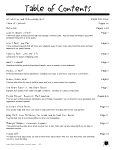 Joi* tke Tree Hole Mojito Patrol1. ......................................... Page 14
Includes cool facts about mosquitoes, as well as information about where they live and what kids can do
to eliminate their breeding grounds and to avoid getting bitten.
Mo^ito-Fatit^ Macki*e; .................................................. Page 15
Presents information about bats, their role in controlling mosquitoes, and how kids can build bat houses.
Pert; Have l^efie;, Tool Aphid; a*d Ladyb^; ............................... Page 16
Explains how aphids damage plants and how ladybugs can be used to eliminate aphids.
Mat'; ALL the B^zz? [[[ Page 17
Shows kids how to tell the difference between bees and wasps and how to avoid being stung.
Mo*;ter Caterpillar [[[ Page 18
After completing this word scramble, kids will understand the life cycle of the gypsy moth, America's
number one tree pest, and the various tree species it likes to eat.
iA/i;e <;p to iA/orf<; [[[ Page 19
Teaches kids about the importance of earth worms to soil health and the various parts of these fascinating
creatures.
Crazy abo<;t Comport [[[ Page 20
This activity teaches kids why compost is important, and how to make and use it.
Page 21
Y Mi;; M^LcU
Includes a neat outdoor activity on mulch.
The lA/eb of life [[[ Page 22
Gives instructions to help kids draw one of the creatures they have learned about in this activity book.
Pla* for Pe;ticide Safety1. ................................................. Page 23
Explains the dangers of pesticides and how kids can avoid being exposed to them.
Are y^ GMLi^ecJ for Pe;t PatfoL? ......................................... Page 24
This quiz will test your student's knowledge of the concepts presented in this activity book.
6Lo;;aKy [[[ Page 25
Li;t ............ image:
Joi* tke Tree Hole Mojito Patrol1. ......................................... Page 14
Includes cool facts about mosquitoes, as well as information about where they live and what kids can do
to eliminate their breeding grounds and to avoid getting bitten.
Mo^ito-Fatit^ Macki*e; .................................................. Page 15
Presents information about bats, their role in controlling mosquitoes, and how kids can build bat houses.
Pert; Have l^efie;, Tool Aphid; a*d Ladyb^; ............................... Page 16
Explains how aphids damage plants and how ladybugs can be used to eliminate aphids.
Mat'; ALL the B^zz? [[[ Page 17
Shows kids how to tell the difference between bees and wasps and how to avoid being stung.
Mo*;ter Caterpillar [[[ Page 18
After completing this word scramble, kids will understand the life cycle of the gypsy moth, America's
number one tree pest, and the various tree species it likes to eat.
iA/i;e <;p to iA/orf<; [[[ Page 19
Teaches kids about the importance of earth worms to soil health and the various parts of these fascinating
creatures.
Crazy abo<;t Comport [[[ Page 20
This activity teaches kids why compost is important, and how to make and use it.
Page 21
Y Mi;; M^LcU
Includes a neat outdoor activity on mulch.
The lA/eb of life [[[ Page 22
Gives instructions to help kids draw one of the creatures they have learned about in this activity book.
Pla* for Pe;ticide Safety1. ................................................. Page 23
Explains the dangers of pesticides and how kids can avoid being exposed to them.
Are y^ GMLi^ecJ for Pe;t PatfoL? ......................................... Page 24
This quiz will test your student's knowledge of the concepts presented in this activity book.
6Lo;;aKy [[[ Page 25
Li;t ............ image:
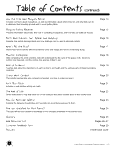 V a Pert?
CD
-C
The world has more insects than all other living
things combined. We need insects! Many insects
work for us. They visit flowers and spread pollen
so plants can produce fruits and vegetables. Some v
insects eat other insects that damage plants. These
"worker" insects are welcome guests.
All insects have a place in the web of life. However
some insects are a nuisance and some can be , , Cn,
Look rof
harmful. We call insects pests when they hurt, co^t
damage, destroy, or make us or our animals sick. YoAL k"
Pert;
When are insects pests? And when are they welcome guests?
In the boxes mark P for pest or G for guest.
O
Fill in the blanks below.
Ant, bee, cockroach, grub, mosquito, spider, wasp, worm
O It chews and kills corn
plants. No corn for us!
It bites into apples.
I
O It pollinates
flowers and
crops.
© It can
trigger an
asthma attack.
© It preys on other
insects that may harm plants
)lts bite can give your
dog or cat heartworm
disease.
O It shows up at
your picnic.
It may sting. Ouch!
book
sot*e wayf to fi^kt tke pert;
to tKe eartk
Uaft
United States Environmental Protection Agency 2003
(See answers inside back cover.)
image:
V a Pert?
CD
-C
The world has more insects than all other living
things combined. We need insects! Many insects
work for us. They visit flowers and spread pollen
so plants can produce fruits and vegetables. Some v
insects eat other insects that damage plants. These
"worker" insects are welcome guests.
All insects have a place in the web of life. However
some insects are a nuisance and some can be , , Cn,
Look rof
harmful. We call insects pests when they hurt, co^t
damage, destroy, or make us or our animals sick. YoAL k"
Pert;
When are insects pests? And when are they welcome guests?
In the boxes mark P for pest or G for guest.
O
Fill in the blanks below.
Ant, bee, cockroach, grub, mosquito, spider, wasp, worm
O It chews and kills corn
plants. No corn for us!
It bites into apples.
I
O It pollinates
flowers and
crops.
© It can
trigger an
asthma attack.
© It preys on other
insects that may harm plants
)lts bite can give your
dog or cat heartworm
disease.
O It shows up at
your picnic.
It may sting. Ouch!
book
sot*e wayf to fi^kt tke pert;
to tKe eartk
Uaft
United States Environmental Protection Agency 2003
(See answers inside back cover.)
image:
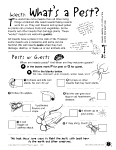 I»;ect
Some bugs help us. Some bugs pester us. All bugs are part of the web
of life. If you think all bugs belong in bug zappers, think again!
Use words from the word bank below to do this puzzle.
Across: ------
1. Large black ant that nests in wood.
2. They get on you to suck your blood.
9. They harm plants by sucking sap.
10. Beautiful insects that drink nectar.
12. Outdoor creepy-crawly that eats
rotten plant matter.
14. Red and black bugs that eat tree
leaves and seeds but don't kill trees.
15. They sting, but also kill harmful
insects.
Mat; tke
eKSwce betv
a coyote a«o| a Aea?
Aphids
Bees
Boxelder
Butterflies
Carpenter
Cockroaches
Fruitflies
Gnats
Houseflies
Mosquitoes
Moth
Spiders
Sowbug
Ticks
Wasps
Down:
1. They eat almost anything, they like
the dark, and they are hard to get
rid of.
3. Tiny, flying insects that breed in
fruits and vegetables.
4. They have eight legs and eat
insects.
5. It eats holes in wool and fur clothing.
6. They spread germs with their feet.
Frogs eat them.
7. Small, flying bugs. The female's bite
is itchy.
8. They give itchy bites. Bats eat them.
13. They sting, but also make food that
humans eat.
a./.oAo;>
United States Environmental Protection Agency 2003
image:
I»;ect
Some bugs help us. Some bugs pester us. All bugs are part of the web
of life. If you think all bugs belong in bug zappers, think again!
Use words from the word bank below to do this puzzle.
Across: ------
1. Large black ant that nests in wood.
2. They get on you to suck your blood.
9. They harm plants by sucking sap.
10. Beautiful insects that drink nectar.
12. Outdoor creepy-crawly that eats
rotten plant matter.
14. Red and black bugs that eat tree
leaves and seeds but don't kill trees.
15. They sting, but also kill harmful
insects.
Mat; tke
eKSwce betv
a coyote a«o| a Aea?
Aphids
Bees
Boxelder
Butterflies
Carpenter
Cockroaches
Fruitflies
Gnats
Houseflies
Mosquitoes
Moth
Spiders
Sowbug
Ticks
Wasps
Down:
1. They eat almost anything, they like
the dark, and they are hard to get
rid of.
3. Tiny, flying insects that breed in
fruits and vegetables.
4. They have eight legs and eat
insects.
5. It eats holes in wool and fur clothing.
6. They spread germs with their feet.
Frogs eat them.
7. Small, flying bugs. The female's bite
is itchy.
8. They give itchy bites. Bats eat them.
13. They sting, but also make food that
humans eat.
a./.oAo;>
United States Environmental Protection Agency 2003
image:
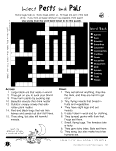 Many scientists are
trying to find ways to
fight pests. One way
is to use pests of
pests, or the
three Ps!
fke
hunt and kill pests for food.
PcirdSllGS live on or inside pests
and also may kill them.
I cltnOC|GnS cause disease in pests.
Pathogens are germs like bacteria or viruses.
*
Acti
on
In the examples below, which of
the 3 Ps is fighting pests?
OBugs are attacking the plants in your
school playground. Upon close
inspection, you find tiny insects
called scales on plant leaves.
Insect killers (insecticides) would
kill the scales, but might also
harm other creatures in the
playground. Also, school officials
do not want to use insecticides
where kids play. School officials
work with agricultural extension agents
to put tiny stingless wasps to work. These
wasps lay their eggs inside the pesty scales.
Wasp larvae hatch and grow inside the
scales. That kills the scales.
O
The brown bat
can catch 1,200
mosquito-sized
insects in just
one hour.
P-
O Japanese beetles have invaded
America. They eat roots, leaves, flower
buds and fruit. They
can kill bushes, trees,
grasses, and garden
and field crops. Now
a germ is on the job.
It causes a disease
that kills the
Japanese beetle.
P-
Imagine you are
one of the 3 Ps.
Make a poster to
advertise yourself.
United States Environmental Protection Agency 2003
image:
Many scientists are
trying to find ways to
fight pests. One way
is to use pests of
pests, or the
three Ps!
fke
hunt and kill pests for food.
PcirdSllGS live on or inside pests
and also may kill them.
I cltnOC|GnS cause disease in pests.
Pathogens are germs like bacteria or viruses.
*
Acti
on
In the examples below, which of
the 3 Ps is fighting pests?
OBugs are attacking the plants in your
school playground. Upon close
inspection, you find tiny insects
called scales on plant leaves.
Insect killers (insecticides) would
kill the scales, but might also
harm other creatures in the
playground. Also, school officials
do not want to use insecticides
where kids play. School officials
work with agricultural extension agents
to put tiny stingless wasps to work. These
wasps lay their eggs inside the pesty scales.
Wasp larvae hatch and grow inside the
scales. That kills the scales.
O
The brown bat
can catch 1,200
mosquito-sized
insects in just
one hour.
P-
O Japanese beetles have invaded
America. They eat roots, leaves, flower
buds and fruit. They
can kill bushes, trees,
grasses, and garden
and field crops. Now
a germ is on the job.
It causes a disease
that kills the
Japanese beetle.
P-
Imagine you are
one of the 3 Ps.
Make a poster to
advertise yourself.
United States Environmental Protection Agency 2003
image:
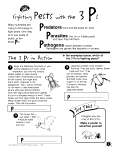 Mat; a
A weed is a plant growing where you don't want
it. Weeds steal sunlight, growing space, and
moisture from grass and
plants we do want.
Weeds spread by seeds.
Pull weeds before they set
seeds. Then you'll have fewer
weeds in the future!
Fach letter is something
pfants (including weeds)
-i to survive.
"feedf
Y pLace
L li^t
fW
— —
Tipf
Take a whack
at weeds!
or hoe weed's out
sure to get every tiny
of root so the weed
Doesn't grow back.
|
x
"Leave;
of three,
let it be."
Poison ivy is a pest when it grows
where we hike or play. It gives you an
itchy rash and weepy blisters. Is
* poison ivy good for anything?
* ^ Some animals and birds eat
*^ the leaves and berries.
^ * Bees sip nectar
X.%^OA ^b, % from the
*%_ °'©^ * % flowers.
ss/^/0 %. %
^f^ry^O, <!b ^
'Of-, v * '-Yj, "*.
c/f St A)/ *
s$/, %.%/, . ^T
' best time to get rid
o weeds Is when they
are small y
•v«
more easily
moist soil.
Milkweed can be a pest when it
grows in fields of crops. But what
would happen if it disappeared?
Monarch caterpillars eat milkweed.
Without milkweed, what would
happen to monarchs?
spjiq 0} peq
ueujM asneoaq
seiyjennq
P!Q
United States Environmental Protection Agency 2003
image:
Mat; a
A weed is a plant growing where you don't want
it. Weeds steal sunlight, growing space, and
moisture from grass and
plants we do want.
Weeds spread by seeds.
Pull weeds before they set
seeds. Then you'll have fewer
weeds in the future!
Fach letter is something
pfants (including weeds)
-i to survive.
"feedf
Y pLace
L li^t
fW
— —
Tipf
Take a whack
at weeds!
or hoe weed's out
sure to get every tiny
of root so the weed
Doesn't grow back.
|
x
"Leave;
of three,
let it be."
Poison ivy is a pest when it grows
where we hike or play. It gives you an
itchy rash and weepy blisters. Is
* poison ivy good for anything?
* ^ Some animals and birds eat
*^ the leaves and berries.
^ * Bees sip nectar
X.%^OA ^b, % from the
*%_ °'©^ * % flowers.
ss/^/0 %. %
^f^ry^O, <!b ^
'Of-, v * '-Yj, "*.
c/f St A)/ *
s$/, %.%/, . ^T
' best time to get rid
o weeds Is when they
are small y
•v«
more easily
moist soil.
Milkweed can be a pest when it
grows in fields of crops. But what
would happen if it disappeared?
Monarch caterpillars eat milkweed.
Without milkweed, what would
happen to monarchs?
spjiq 0} peq
ueujM asneoaq
seiyjennq
P!Q
United States Environmental Protection Agency 2003
image:
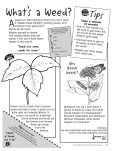 or not?
Many people think dandelions make lawns
ugly. Dandelions crowd out grass and can
damage sidewalks and pavements. But
people long ago thought dandelions were
dandy. They used them for medicines. They
made fried flower blossoms and leafy salads.
They boiled and fried roots and made roasted
root tea. Some people still do!
n THIJl
What can you do with
dandelions?
• Make a bouquet.
• Make a dandelion chain.
Pick several dandelions
with long stems. Make a
small slit in the dandelion
stems. Poke the end of
the stem from one
dandelion through the slit
on another dandelion.
Repeat until you have a
chain of dandelions.
•Tie-dye a t-shirt! The
dandelion's yellow
flowers, green leaves,
and red roots can be
used to make colorful
dyes.
Color the dandelion. In the blanks, write the name
of the plant part and possible uses for the part.
•spaas am i&a spjig jspaas
uo/iapuep ooe jaAO aonpcud
uo/iapuep
'S}oasuj jo} jeioau pue uajjod
UOIjapUBQ
lui}Li'uojiapuep/uojiapuep/p/f}/uis/6jo'UJUJS'MMM//:d}}Li
ajoLU JQJ -(etosauu/iA/ p umasnj/y
LUOJI ABMB sai/ui peas e AJJBO UBO puiM 6uoj)s y -
Au/} ay\\\ jdABj} Aaq± 'pu/M aqi Aq paujBO ajB spaas uoijapuBQ
United States Environmental Protection Agency 2003
image:
or not?
Many people think dandelions make lawns
ugly. Dandelions crowd out grass and can
damage sidewalks and pavements. But
people long ago thought dandelions were
dandy. They used them for medicines. They
made fried flower blossoms and leafy salads.
They boiled and fried roots and made roasted
root tea. Some people still do!
n THIJl
What can you do with
dandelions?
• Make a bouquet.
• Make a dandelion chain.
Pick several dandelions
with long stems. Make a
small slit in the dandelion
stems. Poke the end of
the stem from one
dandelion through the slit
on another dandelion.
Repeat until you have a
chain of dandelions.
•Tie-dye a t-shirt! The
dandelion's yellow
flowers, green leaves,
and red roots can be
used to make colorful
dyes.
Color the dandelion. In the blanks, write the name
of the plant part and possible uses for the part.
•spaas am i&a spjig jspaas
uo/iapuep ooe jaAO aonpcud
uo/iapuep
'S}oasuj jo} jeioau pue uajjod
UOIjapUBQ
lui}Li'uojiapuep/uojiapuep/p/f}/uis/6jo'UJUJS'MMM//:d}}Li
ajoLU JQJ -(etosauu/iA/ p umasnj/y
LUOJI ABMB sai/ui peas e AJJBO UBO puiM 6uoj)s y -
Au/} ay\\\ jdABj} Aaq± 'pu/M aqi Aq paujBO ajB spaas uoijapuBQ
United States Environmental Protection Agency 2003
image:
 It's hard for crabgrass and weeds to take over healthy grass.
Grass that is healthy should require few, if any, chemical
weed and insect killers. What times of the year do people
feed (fertilize) grass to keep it strong and healthy?
A bear can help your family remember
the right times to fertilize grass.
In winter, a bear sleeps. It eats
nothing.
Grass needs
In spring, bears are hungry when
they wake up. They need food.
In summer, bears get what they
need without extra help.
Grass needs
In fall, a bear pigs out before it
hibernates.
Grass needs
Dress each bear for the season.
Tip for Grown-ups:
Use a mulching mower to put nutrients back without fertilizing.
Mow grass at a height of 2.5 to 4 inches to help screen out light to the soil
surface. This slows growth of weeds like crabgrass that need light to germinate
Grass also grows a deeper root system, which helps it tolerate stress.
Check with your local agricultural extension service to find the right
time of year to fertilize your lawn where you live.
United States Environmental Protection Agency 2003
image:
It's hard for crabgrass and weeds to take over healthy grass.
Grass that is healthy should require few, if any, chemical
weed and insect killers. What times of the year do people
feed (fertilize) grass to keep it strong and healthy?
A bear can help your family remember
the right times to fertilize grass.
In winter, a bear sleeps. It eats
nothing.
Grass needs
In spring, bears are hungry when
they wake up. They need food.
In summer, bears get what they
need without extra help.
Grass needs
In fall, a bear pigs out before it
hibernates.
Grass needs
Dress each bear for the season.
Tip for Grown-ups:
Use a mulching mower to put nutrients back without fertilizing.
Mow grass at a height of 2.5 to 4 inches to help screen out light to the soil
surface. This slows growth of weeds like crabgrass that need light to germinate
Grass also grows a deeper root system, which helps it tolerate stress.
Check with your local agricultural extension service to find the right
time of year to fertilize your lawn where you live.
United States Environmental Protection Agency 2003
image:
 Placer,
/
you do best in a certain kind of habitat. So
do plants! To grow and thrive, it's important
to have the right conditions. Be a friend to
plants. Notice where each grows best. Then let
it grow there!
Walk around your lawn, schoolyard, or
neighborhood park. Notice where different plants
grow well. What is it like? Is it wet or dry? Shady
or sunny? Are there places where nothing grows?
Use what you learned on your walk. Draw ferns,
cattails, flowers, and other plants where each
would grow best.
Make a path from the cabin to the lake.
Put the right plants in the right places.
Habitat are tke be;t
Tips for Grown-ups:
United States Environmental Protection Agency 2003
Use native plants in your landscape. Not only are they interesting,
* but they also result in less water use; less need for pesticides and
fertilizers; and better habitat for butterflies, birds, and other wildlife.
See:
U.S. EPA's Green Landscaping with Native Plants
http://www.epa.gov/greenacres/
EPA Mid-Atlantic Region Green Landscaping
* www.epa.gov/reg3esd1/garden/index.htm
Audubon at Home
http://www.audubon.org/bird/at_home/index.html
National Wildlife Federation Backyard Wildlife Habitat Program
http://www.nwf.org/backyardwildlifehabitat/
The Nature Conservancy's Wildland Invasive Species Team Web Site
http://tncweeds.ucdavis.edu/
image:
Placer,
/
you do best in a certain kind of habitat. So
do plants! To grow and thrive, it's important
to have the right conditions. Be a friend to
plants. Notice where each grows best. Then let
it grow there!
Walk around your lawn, schoolyard, or
neighborhood park. Notice where different plants
grow well. What is it like? Is it wet or dry? Shady
or sunny? Are there places where nothing grows?
Use what you learned on your walk. Draw ferns,
cattails, flowers, and other plants where each
would grow best.
Make a path from the cabin to the lake.
Put the right plants in the right places.
Habitat are tke be;t
Tips for Grown-ups:
United States Environmental Protection Agency 2003
Use native plants in your landscape. Not only are they interesting,
* but they also result in less water use; less need for pesticides and
fertilizers; and better habitat for butterflies, birds, and other wildlife.
See:
U.S. EPA's Green Landscaping with Native Plants
http://www.epa.gov/greenacres/
EPA Mid-Atlantic Region Green Landscaping
* www.epa.gov/reg3esd1/garden/index.htm
Audubon at Home
http://www.audubon.org/bird/at_home/index.html
National Wildlife Federation Backyard Wildlife Habitat Program
http://www.nwf.org/backyardwildlifehabitat/
The Nature Conservancy's Wildland Invasive Species Team Web Site
http://tncweeds.ucdavis.edu/
image:
 ica'; Mort
Purple loosestrife is pretty
—and pretty dangerous.
Why? This weed hogs the
land and crowds out native plants
and wildlife. It causes trouble
when it grows in wetlands. The
stems and roots are so tough
that boats and wildlife can't get
through. Other plant life can't
survive where purple loosestrife
takes over. Then wetland animals
lose their food and shelter.
When purple loosestrife was
brought to North America,
its natural enemies were left
behind. With nothing to stop it,
the plants spread like wildfire.
Now something's bugging purple
loosestrife. Experts brought
natural insect enemies from
Europe to eat the plants. These
beetles can slow purple
loosestrife's spread.
tnoA jeeu uepjeB
i ^* e/djnd uees noA
^FPrr.4 a/ief/ ~seeq AeuoLj
^^^ joj. eojnos uenod & se
;/ 5iy/sn Xg pu& suepj&6
ui 11 Buijuvid Aq ejuisesooi e/djnd jo
p&ejds em pes&ejou/ eA&y
P!Q
WANTED
be;t voay to -^et K'IO|
loo;e;tnfe i; to p^LL it
by da^ol i^ Late Jw*e,
ea^Ly Ay^t,
tl^e pLa^t l^a;
to
Unscramble the words to see the only states where purple loosestrife does NOT grow!
ORADFIL AWIIHA
United States Environmental Protection Agency 2003
image:
ica'; Mort
Purple loosestrife is pretty
—and pretty dangerous.
Why? This weed hogs the
land and crowds out native plants
and wildlife. It causes trouble
when it grows in wetlands. The
stems and roots are so tough
that boats and wildlife can't get
through. Other plant life can't
survive where purple loosestrife
takes over. Then wetland animals
lose their food and shelter.
When purple loosestrife was
brought to North America,
its natural enemies were left
behind. With nothing to stop it,
the plants spread like wildfire.
Now something's bugging purple
loosestrife. Experts brought
natural insect enemies from
Europe to eat the plants. These
beetles can slow purple
loosestrife's spread.
tnoA jeeu uepjeB
i ^* e/djnd uees noA
^FPrr.4 a/ief/ ~seeq AeuoLj
^^^ joj. eojnos uenod & se
;/ 5iy/sn Xg pu& suepj&6
ui 11 Buijuvid Aq ejuisesooi e/djnd jo
p&ejds em pes&ejou/ eA&y
P!Q
WANTED
be;t voay to -^et K'IO|
loo;e;tnfe i; to p^LL it
by da^ol i^ Late Jw*e,
ea^Ly Ay^t,
tl^e pLa^t l^a;
to
Unscramble the words to see the only states where purple loosestrife does NOT grow!
ORADFIL AWIIHA
United States Environmental Protection Agency 2003
image:
 BEWARE
Stop Purple Loosestrife!
°
Don't buy them!
• clogs rivers and lakes
[crowds out native plants
n
name of this weed!
S8l|OU| J88J
" ^^i 10 ^n
• ^^T ^ * I
01 dn MOJB uvo ajuisasoo/ e/djnd ^/woi
'uns //n; pue //os ;s/ouy i/;//i/i w
i«i^oA
P!Q
^ Tip for Grown-ups:
* Pulling purple loosestrife? Thoroughly brush off your clothes and equipment before leaving the site so you don't
transport the small seeds to new areas. Put all purple loosestrife plant pieces in plastic bags (vegetation rots quickly
in plastic). Take the bags to a sanitary landfill site. Be sure the landfill site doesn't require bags to be broken open for
composting. Composting is not advised, as purple loosestrife seeds may not be destroyed and the thick, woody
stems and roots take a long time to decompose. If facilities exist in your area, incineration is an effective way to
dispose of plant material.
United States Environmental Protection Agency 2003
image:
BEWARE
Stop Purple Loosestrife!
°
Don't buy them!
• clogs rivers and lakes
[crowds out native plants
n
name of this weed!
S8l|OU| J88J
" ^^i 10 ^n
• ^^T ^ * I
01 dn MOJB uvo ajuisasoo/ e/djnd ^/woi
'uns //n; pue //os ;s/ouy i/;//i/i w
i«i^oA
P!Q
^ Tip for Grown-ups:
* Pulling purple loosestrife? Thoroughly brush off your clothes and equipment before leaving the site so you don't
transport the small seeds to new areas. Put all purple loosestrife plant pieces in plastic bags (vegetation rots quickly
in plastic). Take the bags to a sanitary landfill site. Be sure the landfill site doesn't require bags to be broken open for
composting. Composting is not advised, as purple loosestrife seeds may not be destroyed and the thick, woody
stems and roots take a long time to decompose. If facilities exist in your area, incineration is an effective way to
dispose of plant material.
United States Environmental Protection Agency 2003
image:
 N
CM
X CO
> v>
(O
</> co
i- O)
cr
o J!
E ?
ertrl
Do pests bug you? Keep
them from getting into
your home, yard, or
garden in the first place.
Use the code to fill in the
blanks. You'll see ways to
outsmart pesty insects,
weeds, and diseases.
6 13 21 15 12 4 22 9
and plants with berries. These attract birds
to feast on insects that harm plants.
Welcome
7
They eat
8 15 6 20
that eat and damage plants.
12
26
23
O
O O
Clean up
Take
24 9 6 14 25 8
Wipe up spills. Keep rooms clean.
0>
20
O)
- CM
CD N
26 9 25 26 20
and recycling outdoors.
Put
22
CO
(O
CM
8 24 9 22 22 13 8
on doors and windows. Keep insects out!
Stake up
_to keep
7 12 14 26 7 12 22 8
their leaves off the ground. Water them with a can or
bucket, not a spray. Then spores that live in the soil won't
splash up on the plants and make them sick.
United States Environmental Protection Agency 2003
image:
N
CM
X CO
> v>
(O
</> co
i- O)
cr
o J!
E ?
ertrl
Do pests bug you? Keep
them from getting into
your home, yard, or
garden in the first place.
Use the code to fill in the
blanks. You'll see ways to
outsmart pesty insects,
weeds, and diseases.
6 13 21 15 12 4 22 9
and plants with berries. These attract birds
to feast on insects that harm plants.
Welcome
7
They eat
8 15 6 20
that eat and damage plants.
12
26
23
O
O O
Clean up
Take
24 9 6 14 25 8
Wipe up spills. Keep rooms clean.
0>
20
O)
- CM
CD N
26 9 25 26 20
and recycling outdoors.
Put
22
CO
(O
CM
8 24 9 22 22 13 8
on doors and windows. Keep insects out!
Stake up
_to keep
7 12 14 26 7 12 22 8
their leaves off the ground. Water them with a can or
bucket, not a spray. Then spores that live in the soil won't
splash up on the plants and make them sick.
United States Environmental Protection Agency 2003
image:
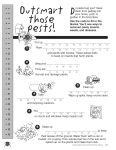 Keep Pests from Pestering You
Inside and Outside Your House!
Kitchen pests like
cereal, flour, oatmeal,
crackers, and pancake
mix. Travel the maze to
see which containers
pests can get into.
Weac
clotk/tv=j ;o yo
ca* fee
tke tick;.
BeA>fe applyi^ a
perficiole, Read fke
Lakel FIRM Be ;*ce to
follow tke M;tfucti
1
f Tip for Grown-ups:
,*>• Think you've got pests? Identify the pest problem before you decide what to do. Some
pests (or signs of them) are easy to spot. But sometimes we are fooled. What looks like a
* plant "disease" may actually be a sign of poor soil or lack of water. To help you identify
f your pest and learn the most effective ways to control it, use free sources from the library or
local nurseries. Or contact your local Cooperative Research, Education, and Extension
* Service, (http://www.reeusda.gov/1700/statepartners/usa.htm)
United States Environmental Protection Agency 2003
image:
Keep Pests from Pestering You
Inside and Outside Your House!
Kitchen pests like
cereal, flour, oatmeal,
crackers, and pancake
mix. Travel the maze to
see which containers
pests can get into.
Weac
clotk/tv=j ;o yo
ca* fee
tke tick;.
BeA>fe applyi^ a
perficiole, Read fke
Lakel FIRM Be ;*ce to
follow tke M;tfucti
1
f Tip for Grown-ups:
,*>• Think you've got pests? Identify the pest problem before you decide what to do. Some
pests (or signs of them) are easy to spot. But sometimes we are fooled. What looks like a
* plant "disease" may actually be a sign of poor soil or lack of water. To help you identify
f your pest and learn the most effective ways to control it, use free sources from the library or
local nurseries. Or contact your local Cooperative Research, Education, and Extension
* Service, (http://www.reeusda.gov/1700/statepartners/usa.htm)
United States Environmental Protection Agency 2003
image:
 Cockroaches love living with
people. Homes give them lots of
food and cozy spaces to rest and
breed. But no one wants cockroaches
in their home. They smell bad. They run
all over at night. They can cause
allergies, too.
To get rid of roaches, think like a roach.
What would make you leave a cozy
human home? ... ^
Get
to do:
What's yummy to a roach? Search
for the hidden words to find out.
Then make sure the roaches won't
get to these goodies in your home!
V
F
P
Z
C
Q
H
Y
U
S
Q
u
o
u
Z
1 p
R N
I N
M B
G E
Z S
wx
T H
A G
X U
R E
C X
L L
S P
W P
H U
Q D
U
G
T
V
G
L
U
E
0
N
N
P
0
E
A
0
J
E
S
K
V
V
B
I
W
A
D
S
L
U
P
R
YQ
R N
J H
B S
O O
S D
E D
Q z
I Q
C S
F Y
C W
X O
V W
E T
MM
S P
A I
W G
T D
P I
O E
E K
Y J
V L
O A
T C
K H
B C
M G
F O
Y D
C G
L C
U G
I K
Q V
C L
A B
B N
I I
P M
K X
XQ
Y U
F N
O D
B A
D J
L I
D U
I G
P Z
E H
V Y
H O
U L
N T
Z D
U H
O J
N W
P F
Z X
H H
P P
Y D
Z O
I C
R W
W I
M P
D L
I F
B L
I U
WN
E C
M L
F R
J
I
R
G
R
E
A
S
E
I
M
G
T
G
F
H
R Z
N G
R I
V B
G A
E M
C I
R K
S M
K U
P N
C H
XQ
T K
S E
P Y
T
S
Y
O
W
W
G
L
C
C
R
U
M
B
S
R
aSfoot the garbage every da,
D?eep food in ciosed container.
O Don't leave dirty dishes in the
sink overnight.
D wash food from cans before
°
Word Bank: peanut butter; fingernail clippings;
crumbs; pet food; glue; bookbindings; grease; soap
•S9LUOLI u_i punojB IBO/J. su/ys
asdu.± 'SdiBjdUB di# asnBO
Adift uaijM pays
suiys 9Lj± -spy AUBLU ui BLULJISB
asnBO UBO sdqo&ojyoo
•sajOLj PUB syowo
dijs Ajis&d Adqi pu&
i }eoo Axe/M j/atyj. 'a/fe jnoA
yui/q ueo noA UBLH J&ISBJ. JSUBOS saqosoy
P!Q
_£
'-£
Nasty! When they eat, cockroaches barf a little
bit. They also leave poop. These smelly things mark
the spot so the roaches can find food later.
United States Environmental Protection Agency 2003
image:
Cockroaches love living with
people. Homes give them lots of
food and cozy spaces to rest and
breed. But no one wants cockroaches
in their home. They smell bad. They run
all over at night. They can cause
allergies, too.
To get rid of roaches, think like a roach.
What would make you leave a cozy
human home? ... ^
Get
to do:
What's yummy to a roach? Search
for the hidden words to find out.
Then make sure the roaches won't
get to these goodies in your home!
V
F
P
Z
C
Q
H
Y
U
S
Q
u
o
u
Z
1 p
R N
I N
M B
G E
Z S
wx
T H
A G
X U
R E
C X
L L
S P
W P
H U
Q D
U
G
T
V
G
L
U
E
0
N
N
P
0
E
A
0
J
E
S
K
V
V
B
I
W
A
D
S
L
U
P
R
YQ
R N
J H
B S
O O
S D
E D
Q z
I Q
C S
F Y
C W
X O
V W
E T
MM
S P
A I
W G
T D
P I
O E
E K
Y J
V L
O A
T C
K H
B C
M G
F O
Y D
C G
L C
U G
I K
Q V
C L
A B
B N
I I
P M
K X
XQ
Y U
F N
O D
B A
D J
L I
D U
I G
P Z
E H
V Y
H O
U L
N T
Z D
U H
O J
N W
P F
Z X
H H
P P
Y D
Z O
I C
R W
W I
M P
D L
I F
B L
I U
WN
E C
M L
F R
J
I
R
G
R
E
A
S
E
I
M
G
T
G
F
H
R Z
N G
R I
V B
G A
E M
C I
R K
S M
K U
P N
C H
XQ
T K
S E
P Y
T
S
Y
O
W
W
G
L
C
C
R
U
M
B
S
R
aSfoot the garbage every da,
D?eep food in ciosed container.
O Don't leave dirty dishes in the
sink overnight.
D wash food from cans before
°
Word Bank: peanut butter; fingernail clippings;
crumbs; pet food; glue; bookbindings; grease; soap
•S9LUOLI u_i punojB IBO/J. su/ys
asdu.± 'SdiBjdUB di# asnBO
Adift uaijM pays
suiys 9Lj± -spy AUBLU ui BLULJISB
asnBO UBO sdqo&ojyoo
•sajOLj PUB syowo
dijs Ajis&d Adqi pu&
i }eoo Axe/M j/atyj. 'a/fe jnoA
yui/q ueo noA UBLH J&ISBJ. JSUBOS saqosoy
P!Q
_£
'-£
Nasty! When they eat, cockroaches barf a little
bit. They also leave poop. These smelly things mark
the spot so the roaches can find food later.
United States Environmental Protection Agency 2003
image:
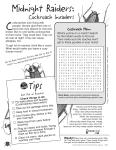 Tcked * Off.
Ticks are pests that live off blood. They
find the blood in people and animals.
While feasting on their host, ticks can
pass along sicknesses like Lyme Disease.
Ticks wait for their food to come to them.
Ticks can sense body heat and carbon
dioxide—a gas people and animals breathe
out—to find prey. When blood sources like
humans brush against them, ticks hop on.
Ick, a Tick1. ^=*5L_-/
Ticks can be found all over the United States. People
living in the shaded states of the country have a
higher risk of being bitten by ticks carrying the
bacteria that causes Lyme Disease. Mark an "X" on
the state that YOU live in. ^
Pf
*
±QN—wo/s jnoA oiu/ eoe/d
-Ljinoiu peqj&q & eo&id Aem 'LJO&U&
P!d
Ticks live in the woods and tall grass.
They only eat three times: once as
larvae, once as nymphs, and once as
adults.
Photo Courtesy
Minnesota Department
of Health - Disease
Prevention and
Control
Avoid Tick Bites!
3- Ask an adult
<«** off with
*
Source: Centers for Disease Control and Prevention
(http://www.cdc.gov/health/). Cited by the American
Lyme Disease Foundation, Inc.(www.aldf.com/).
For more about Lyme Disease, see:
http://www.cdc.gov/ncidod/dvbid/lyme/
Tip for Grown-ups:
* Ticks attach themselves to your body with their
mouths. The best way to remove them is with
* tweezers, making sure not to leave any tick body
f parts in your skin.
United States Environmental Protection Agency 2003
image:
Tcked * Off.
Ticks are pests that live off blood. They
find the blood in people and animals.
While feasting on their host, ticks can
pass along sicknesses like Lyme Disease.
Ticks wait for their food to come to them.
Ticks can sense body heat and carbon
dioxide—a gas people and animals breathe
out—to find prey. When blood sources like
humans brush against them, ticks hop on.
Ick, a Tick1. ^=*5L_-/
Ticks can be found all over the United States. People
living in the shaded states of the country have a
higher risk of being bitten by ticks carrying the
bacteria that causes Lyme Disease. Mark an "X" on
the state that YOU live in. ^
Pf
*
±QN—wo/s jnoA oiu/ eoe/d
-Ljinoiu peqj&q & eo&id Aem 'LJO&U&
P!d
Ticks live in the woods and tall grass.
They only eat three times: once as
larvae, once as nymphs, and once as
adults.
Photo Courtesy
Minnesota Department
of Health - Disease
Prevention and
Control
Avoid Tick Bites!
3- Ask an adult
<«** off with
*
Source: Centers for Disease Control and Prevention
(http://www.cdc.gov/health/). Cited by the American
Lyme Disease Foundation, Inc.(www.aldf.com/).
For more about Lyme Disease, see:
http://www.cdc.gov/ncidod/dvbid/lyme/
Tip for Grown-ups:
* Ticks attach themselves to your body with their
mouths. The best way to remove them is with
* tweezers, making sure not to leave any tick body
f parts in your skin.
United States Environmental Protection Agency 2003
image:
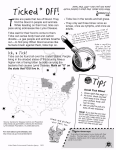 Jo/* tke 7>ee Hole
Patrol!
Mosquitoes bite
and make you
itch. They can
also make you sick.
Some mosquitoes
lay eggs in ponds or
swamps. The tree hole
mosquito can lay eggs
in your yard! It breeds
any place it finds still
or slow-moving water.
That includes tree
holes that hold water.
This mosquito finds
lots of other places to
lay eggs, too. You'll see
10 in the picture. Cross
them out. Then go on a
mosquito patrol in your
own neighborhood.
Turn over empty pots.
Dump water from toys.
Don't grow mosquitoes
in your area!
repellents
avoid over-use of
Pest/c/de products
sunset when
mosquitoes are
active.
United Sfafes Environmental Protection Agency
image:
Jo/* tke 7>ee Hole
Patrol!
Mosquitoes bite
and make you
itch. They can
also make you sick.
Some mosquitoes
lay eggs in ponds or
swamps. The tree hole
mosquito can lay eggs
in your yard! It breeds
any place it finds still
or slow-moving water.
That includes tree
holes that hold water.
This mosquito finds
lots of other places to
lay eggs, too. You'll see
10 in the picture. Cross
them out. Then go on a
mosquito patrol in your
own neighborhood.
Turn over empty pots.
Dump water from toys.
Don't grow mosquitoes
in your area!
repellents
avoid over-use of
Pest/c/de products
sunset when
mosquitoes are
active.
United Sfafes Environmental Protection Agency
image:
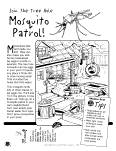 Madder
Mosquitoes have a place
in the food chain, but not
on your skin. Bats and
are mosquito patrols, too. Build
bat house and you'll have
fewer mosquitoes!
A bat eats between
Clues
How many years in a century?
Add a zero.
Bat
House!
• Woodworking for
Wildlife by Carroll
Henderson has
a bat house plan.
You can build it
from one piece of
lumber for $5.00.
For more, see
• http://www.batcon.org/bhra/bhcriter.html
hat does one big brown bat
eat each night? Use the clues
to find out!
Multiply times 3.
(A)
and
(A)
mosquitoes and other
insects each night.
(B)
How many pennies in a dollar?
Multiply times the
number of days in a week.
Add one more zero.
(B)
United States Environmental Protection Agency 2003
image:
Madder
Mosquitoes have a place
in the food chain, but not
on your skin. Bats and
are mosquito patrols, too. Build
bat house and you'll have
fewer mosquitoes!
A bat eats between
Clues
How many years in a century?
Add a zero.
Bat
House!
• Woodworking for
Wildlife by Carroll
Henderson has
a bat house plan.
You can build it
from one piece of
lumber for $5.00.
For more, see
• http://www.batcon.org/bhra/bhcriter.html
hat does one big brown bat
eat each night? Use the clues
to find out!
Multiply times 3.
(A)
and
(A)
mosquitoes and other
insects each night.
(B)
How many pennies in a dollar?
Multiply times the
number of days in a week.
Add one more zero.
(B)
United States Environmental Protection Agency 2003
image:
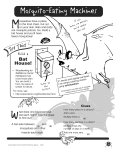 Aphids are tiny insect pests. They suck
the sap from plants—vegetables, crops,
flowers, and trees. They take away the
plant's nutrients, and they can give the plant
viruses. Aphids attract even more pests to the
plant with the sweet, sticky juices they make.
Natural enemies that gobble up
aphids are lacewings, assassin bugs,
wasps, spiders, and chickadees.
But ladybugs (ladybird beetles)
are the champion
aphid eaters.
Ladybugs look the same on both sides.
Draw the rest of this ladybug's body.
^ F°r fighting aphids
* Pick off aphids from thp
underside of leave™ or
• Gm? ^ Wlth wat'er.
Grow plants such as
mangolds that attract
aphids'natural enemls
Buv a bag of ladybugs
a garden nursery.
; voo*'t harr-i a*y of^ yo^K pla*t;> but they eat
pert; that <W. Let l^ylo^ ci|o their vooKk!
o* lacilybucj;, vi;it the National
^'; Back YaKcil iviLcilLi^e Habitat ?
agricultural extension
the
Tip for Grown-ups:
When fighting spider mites or aphids, go for
the least toxic ways. You can buy beneficial
insects (enemies of pests) such as ladybugs.
You can also use insecticidal soaps or wash
aphids off plants with your garden hose.
uC; about
auo jaqiunu s.BnqApei am
jspiyde djouj 000'9 o} dn
l&a A&LU it 'unp& u& sy -spiyde OOP inoqe
l&a HIM &AJ&I 6nqAp&i & 'sayoi&y y uay/\/\ •
t
I
i
J
V
United States Environmental Protection Agency 2003
image:
Aphids are tiny insect pests. They suck
the sap from plants—vegetables, crops,
flowers, and trees. They take away the
plant's nutrients, and they can give the plant
viruses. Aphids attract even more pests to the
plant with the sweet, sticky juices they make.
Natural enemies that gobble up
aphids are lacewings, assassin bugs,
wasps, spiders, and chickadees.
But ladybugs (ladybird beetles)
are the champion
aphid eaters.
Ladybugs look the same on both sides.
Draw the rest of this ladybug's body.
^ F°r fighting aphids
* Pick off aphids from thp
underside of leave™ or
• Gm? ^ Wlth wat'er.
Grow plants such as
mangolds that attract
aphids'natural enemls
Buv a bag of ladybugs
a garden nursery.
; voo*'t harr-i a*y of^ yo^K pla*t;> but they eat
pert; that <W. Let l^ylo^ ci|o their vooKk!
o* lacilybucj;, vi;it the National
^'; Back YaKcil iviLcilLi^e Habitat ?
agricultural extension
the
Tip for Grown-ups:
When fighting spider mites or aphids, go for
the least toxic ways. You can buy beneficial
insects (enemies of pests) such as ladybugs.
You can also use insecticidal soaps or wash
aphids off plants with your garden hose.
uC; about
auo jaqiunu s.BnqApei am
jspiyde djouj 000'9 o} dn
l&a A&LU it 'unp& u& sy -spiyde OOP inoqe
l&a HIM &AJ&I 6nqAp&i & 'sayoi&y y uay/\/\ •
t
I
i
J
V
United States Environmental Protection Agency 2003
image:
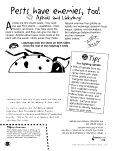 MatV all tke
Honeybees and wasps sting to defend themselves, NOT to
attack. For bees and wasps, stings are a good way to keep
people from bugging them. Bee stings hurt. They can even
be deadly if someone is allergic.
Did
Honeybees collect pollen and carry it in a
basket of stiff hairs on each hind-leg. When
they rest, their wings are flat.
Wasps do not have "pollen baskets" and do not
collect pollen. When they rest, their wings are
folded back and look narrower than a bee's
wings.
Which is which? Label and color
the wasp and the honeybee. Circle the
pollen baskets on the honeybee.
Tw
Prevent Stings! /
Try not to attract bees. If they come i
around, don't frighten them. Check *
what you should do in areas with bees:
D Avoid using scented products. This
means hair spray, scented soaps,
perfume, and lotions.
D Avoid brightly colored clothes,
especially flowered patterns.
D Keep food and soda cans covered.
D Wear hats, shoes, and long pants.
D If a bee comes around,
hold very still.
D If a bee lands on you, don't swat
at it. Don't panic! Just blow at it
gently. It will move.
Fi/rt A)CJI
If you get stung, have an adult
remove the stinger as soon as
possible.
• Wash the sting with soap and water.
• Put ice or cool water on it for
10 to 30 minutes.
• To ease the pain and itching, try
putting one of these on the sting:
alcohol wipes, or a paste made of
k baking soda and water or meat ^ *
\enderizer and water. * #<
1-0
o
.i c
> J*"
N
o> N
o> c
-0 <3-
*• H
t pollinators, vuc wouldn't have agrio
United States Environmental Protection Agency 2003
image:
MatV all tke
Honeybees and wasps sting to defend themselves, NOT to
attack. For bees and wasps, stings are a good way to keep
people from bugging them. Bee stings hurt. They can even
be deadly if someone is allergic.
Did
Honeybees collect pollen and carry it in a
basket of stiff hairs on each hind-leg. When
they rest, their wings are flat.
Wasps do not have "pollen baskets" and do not
collect pollen. When they rest, their wings are
folded back and look narrower than a bee's
wings.
Which is which? Label and color
the wasp and the honeybee. Circle the
pollen baskets on the honeybee.
Tw
Prevent Stings! /
Try not to attract bees. If they come i
around, don't frighten them. Check *
what you should do in areas with bees:
D Avoid using scented products. This
means hair spray, scented soaps,
perfume, and lotions.
D Avoid brightly colored clothes,
especially flowered patterns.
D Keep food and soda cans covered.
D Wear hats, shoes, and long pants.
D If a bee comes around,
hold very still.
D If a bee lands on you, don't swat
at it. Don't panic! Just blow at it
gently. It will move.
Fi/rt A)CJI
If you get stung, have an adult
remove the stinger as soon as
possible.
• Wash the sting with soap and water.
• Put ice or cool water on it for
10 to 30 minutes.
• To ease the pain and itching, try
putting one of these on the sting:
alcohol wipes, or a paste made of
k baking soda and water or meat ^ *
\enderizer and water. * #<
1-0
o
.i c
> J*"
N
o> N
o> c
-0 <3-
*• H
t pollinators, vuc wouldn't have agrio
United States Environmental Protection Agency 2003
image:
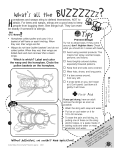 1 ghat's the number one tree pest in the USA? It's the
\A /gypsy moth caterpillar. These large, hungry pests
"V eat the leaves of trees in early summer. This is the
hardest time for trees to repair themselves. Gypsy moth
caterpillars damage and kill trees.
Gypsy moth caterpillars also bug humans. In early
summer, they hang and drop from trees. They mess
up outdoor areas where humans like to relax. Their
hair also causes allergic reactions in some people,
What kinds of trees do gypsy moths like best?
To find out, unscramble the trees this caterpillar ate.
WORD BANK
apple
aspen
basswood
birch
maple
crabapple
oak
poplar
box elder
willow
£
V
\
^
\
1
:
•J
X
earn to identify the gypsy moth in every stage of development.
Number the life cycle stages in right order, from egg to adult.
http://www.fs.fed.us/ne/morgantown/4557/ginoth/
•>! < -• MJP^%r-Owjwpwip»i "\, ./ ','»;, '' " ,'•',". '-,•!-*.%
•' -, " ;Wher» plahting frees," brtos^ 9ps^i^s that gypsy nioths df ^t,^ Tly A$f>,, Dogwood, %
'*• <"«4" - JuniP^ef'UN«Sy^mpre,:ArboiyMei'Hojf}8yl$C|i4t,Qr,Northern Catalpa^,' , ' -'' '•
-••„ 10. oxb amw
a) =
United States Environmental Protection Agency 2003
image:
1 ghat's the number one tree pest in the USA? It's the
\A /gypsy moth caterpillar. These large, hungry pests
"V eat the leaves of trees in early summer. This is the
hardest time for trees to repair themselves. Gypsy moth
caterpillars damage and kill trees.
Gypsy moth caterpillars also bug humans. In early
summer, they hang and drop from trees. They mess
up outdoor areas where humans like to relax. Their
hair also causes allergic reactions in some people,
What kinds of trees do gypsy moths like best?
To find out, unscramble the trees this caterpillar ate.
WORD BANK
apple
aspen
basswood
birch
maple
crabapple
oak
poplar
box elder
willow
£
V
\
^
\
1
:
•J
X
earn to identify the gypsy moth in every stage of development.
Number the life cycle stages in right order, from egg to adult.
http://www.fs.fed.us/ne/morgantown/4557/ginoth/
•>! < -• MJP^%r-Owjwpwip»i "\, ./ ','»;, '' " ,'•',". '-,•!-*.%
•' -, " ;Wher» plahting frees," brtos^ 9ps^i^s that gypsy nioths df ^t,^ Tly A$f>,, Dogwood, %
'*• <"«4" - JuniP^ef'UN«Sy^mpre,:ArboiyMei'Hojf}8yl$C|i4t,Qr,Northern Catalpa^,' , ' -'' '•
-••„ 10. oxb amw
a) =
United States Environmental Protection Agency 2003
image:
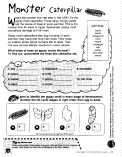 Wise up to
H
ealthy plants more easily resist pests. Good soil grows healthy
plants. And earthworms help make good soil.
Earthworms are little "soil plows." They move bits of soil and
make tunnels. This lets in air and water for animals and plants
in the ground. Worms carry leaf bits and other materials into
the soil, making it richer for plants. Earthworms eat soil and
leave castings, little piles or pellets ("worm poop"). Castings
hold nutrients that passed through the worm, and they
improve the soil. Way to go, worms!
.jcc.
o^r
Worm - a - rama
A cool, moist day or evening is a great
time to find earthworms. Look in
garden soil, vacant lots, lawns, parks,
or pastures.
1. Look at the soil surface.
Castings are clues.
2. Dig a spadeful of soil. Sort through
it for earthworms. Look at them
through a hand lens. Look for:
Setae (bristles that help
worms grip soil and crawl)
Slime coating (keeps skin
moist so worms can breathe)
Front end (usually goes
forward first)
Clitellum ("collar" or band
that's only on adult worms)
3. After you study the worms, put
them back on the soil, please.
Label the clitellum, setae,
and front end.
itsau
II ejojeq siujOMLjiJ&e p
PL vee HIM UIQOJ Aqeq y
United States Environmental Protection Agency 2003
«#3fcv
s?
P!d
,*
image:
Wise up to
H
ealthy plants more easily resist pests. Good soil grows healthy
plants. And earthworms help make good soil.
Earthworms are little "soil plows." They move bits of soil and
make tunnels. This lets in air and water for animals and plants
in the ground. Worms carry leaf bits and other materials into
the soil, making it richer for plants. Earthworms eat soil and
leave castings, little piles or pellets ("worm poop"). Castings
hold nutrients that passed through the worm, and they
improve the soil. Way to go, worms!
.jcc.
o^r
Worm - a - rama
A cool, moist day or evening is a great
time to find earthworms. Look in
garden soil, vacant lots, lawns, parks,
or pastures.
1. Look at the soil surface.
Castings are clues.
2. Dig a spadeful of soil. Sort through
it for earthworms. Look at them
through a hand lens. Look for:
Setae (bristles that help
worms grip soil and crawl)
Slime coating (keeps skin
moist so worms can breathe)
Front end (usually goes
forward first)
Clitellum ("collar" or band
that's only on adult worms)
3. After you study the worms, put
them back on the soil, please.
Label the clitellum, setae,
and front end.
itsau
II ejojeq siujOMLjiJ&e p
PL vee HIM UIQOJ Aqeq y
United States Environmental Protection Agency 2003
«#3fcv
s?
P!d
,*
image:
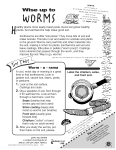 Oazy
Composting saves
landfill space and
turns garbage to
goodness. Try it at home
or at school!
What do you get from
compost? To find out, start
at the arrow and write
down every other letter in
the space below.
roil ^ake; it
t
ou
t.
Tip for Grown-ups:
Use compost instead of chemical *
fertilizers. It's earth-friendly, effective, and
free. Spread compost over the ground at -
the base of plants to give them needed
nutrients.
For an informative slideshow about
composting for kids, see:
http://aggie-horticulture.tamu.edu/
sustainable/slidesets/kidscompost/cover.html
Make your own compost.
at least 3 feet wide
or shovel
to stir the
compost
wood chips
You need:
Garbage \1UJ,OR
and 3 feet deep
Big plastic garbage bags to line the
Soil (with earthworms and bugs)
Twigs or wood
chips
Compost ingredients
A long stick
<m
*3&
24.
23.
Before you start:
Ask an adult to help
you poke 25-30 small
holes in the lid, sides,
and bottom of the can
for air and water.
Step 1. Build up
layers. Each layer is
about 8 inches thick.
Step 2. Pour on
enough water to
moisten the pile.
Step 3. Make more
layers and water them
Step 4. Each time
you add compost
ingredients add
a little soil.
Let *at^KeV KecycleK; cjo to
Use the stick or shovel to mix the pile every two to four days. In
one or two months, your compost will become dark brown and
crumbly. It is ready to use on your lawn, houseplants, or garden!
United States Environmental Protection Agency 2003
Compost
ingredients
image:
Oazy
Composting saves
landfill space and
turns garbage to
goodness. Try it at home
or at school!
What do you get from
compost? To find out, start
at the arrow and write
down every other letter in
the space below.
roil ^ake; it
t
ou
t.
Tip for Grown-ups:
Use compost instead of chemical *
fertilizers. It's earth-friendly, effective, and
free. Spread compost over the ground at -
the base of plants to give them needed
nutrients.
For an informative slideshow about
composting for kids, see:
http://aggie-horticulture.tamu.edu/
sustainable/slidesets/kidscompost/cover.html
Make your own compost.
at least 3 feet wide
or shovel
to stir the
compost
wood chips
You need:
Garbage \1UJ,OR
and 3 feet deep
Big plastic garbage bags to line the
Soil (with earthworms and bugs)
Twigs or wood
chips
Compost ingredients
A long stick
<m
*3&
24.
23.
Before you start:
Ask an adult to help
you poke 25-30 small
holes in the lid, sides,
and bottom of the can
for air and water.
Step 1. Build up
layers. Each layer is
about 8 inches thick.
Step 2. Pour on
enough water to
moisten the pile.
Step 3. Make more
layers and water them
Step 4. Each time
you add compost
ingredients add
a little soil.
Let *at^KeV KecycleK; cjo to
Use the stick or shovel to mix the pile every two to four days. In
one or two months, your compost will become dark brown and
crumbly. It is ready to use on your lawn, houseplants, or garden!
United States Environmental Protection Agency 2003
Compost
ingredients
image:
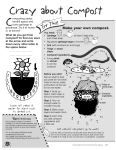 , OK a^i/^aL poop
Cor"po;t. They vo
rake it r^ell bacil—
attract pert;1.1.
t
Fill in the missing vowels.
C ff
gr nds)
O gr ss
cl pp ngs
MULCH is a layer of nonliving materials. People can
spread it on top of the soil around plants. Why use
mulch? Mulch shades and cools the soil. It keeps
moisture in the soil. Mulch protects the soil from
packing down. Best of all, it stops pesty weeds from
growing. Mulch can be:
• Wood chips • Dry leaves
Grass clippings
(with NO weeds or chemical weed killers)
Rocks • Compost
d scr ps
ng ^
s
D)
D)
O
O
How thick should a mulch
layer be? See for yourself!
First, choose two plants growing in your garden,
yard, schoolyard, or nearby park. Then...
1. Put 1 inch of mulch around the
base of plant #1.
2. Put 3 inches of mulch around plant #2.
3. Check in one month.
I predict
This is what happened:
What I want to know now:
n
n
60 o* a M-Ack
How many places can you find mulch around plants?
Gardens D At home D Parks
Schoolyard
D Neighbor's yard
D Boulevards
Place
Kind of mulch
Any Weeds?
Yes
No
7
United States Environmental Protection Agency 2003
Tip for Grown-ups:
Avoid "beaver lodge" mulching around trees. Spread the mulch evenly and
leave a 3-4 inch air space around the base of your tree.
image:
, OK a^i/^aL poop
Cor"po;t. They vo
rake it r^ell bacil—
attract pert;1.1.
t
Fill in the missing vowels.
C ff
gr nds)
O gr ss
cl pp ngs
MULCH is a layer of nonliving materials. People can
spread it on top of the soil around plants. Why use
mulch? Mulch shades and cools the soil. It keeps
moisture in the soil. Mulch protects the soil from
packing down. Best of all, it stops pesty weeds from
growing. Mulch can be:
• Wood chips • Dry leaves
Grass clippings
(with NO weeds or chemical weed killers)
Rocks • Compost
d scr ps
ng ^
s
D)
D)
O
O
How thick should a mulch
layer be? See for yourself!
First, choose two plants growing in your garden,
yard, schoolyard, or nearby park. Then...
1. Put 1 inch of mulch around the
base of plant #1.
2. Put 3 inches of mulch around plant #2.
3. Check in one month.
I predict
This is what happened:
What I want to know now:
n
n
60 o* a M-Ack
How many places can you find mulch around plants?
Gardens D At home D Parks
Schoolyard
D Neighbor's yard
D Boulevards
Place
Kind of mulch
Any Weeds?
Yes
No
7
United States Environmental Protection Agency 2003
Tip for Grown-ups:
Avoid "beaver lodge" mulching around trees. Spread the mulch evenly and
leave a 3-4 inch air space around the base of your tree.
image:
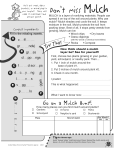 THE
of
FN id you know that there are many more kinds of insects on earth than any other kind of
I t living creature? It's hard to imagine, but 95% of all the animal species on the earth are
•^ insects! Millions of insects can exist in a single acre of land! Over one million species
have been discovered by scientists, and they think that there might be ten times that many
that have not been named yet! All of these insects are part of what is called the "web of life."
Draw and color a picture with a critter you
read about in this book.
Show: what it eats
what eats it
if it helps something grow
Add other organisms to your picture to make
a web of life.
kar a place
the
Tell a friend or parent
what this means.
United States Environmental Protection Agency 2003
image:
THE
of
FN id you know that there are many more kinds of insects on earth than any other kind of
I t living creature? It's hard to imagine, but 95% of all the animal species on the earth are
•^ insects! Millions of insects can exist in a single acre of land! Over one million species
have been discovered by scientists, and they think that there might be ten times that many
that have not been named yet! All of these insects are part of what is called the "web of life."
Draw and color a picture with a critter you
read about in this book.
Show: what it eats
what eats it
if it helps something grow
Add other organisms to your picture to make
a web of life.
kar a place
the
Tell a friend or parent
what this means.
United States Environmental Protection Agency 2003
image:
 Pla* far pert icicle rafetyi
Pla*t;> family, a*<^ Pet;
^ometimes people buy and use pesticides. Pesticides
V are chemicals that get rid of pests. They are poisons.
J Pesticides may accidentally get into our bodies and
make us sick. They can get into our bodies if we touch
them, breathe them, or swallow them. Find
pesticides in the picture. Underline words
that warn you that they are poisons.
BUGBUSltR
DANGER
Be safer from pesticides!
• Either take your shoes off at
the door or wipe shoes
carefully on a rug-type door
mat. How would this help?
• Always store pesticides in
their original container.
How would this help?
Talk with your family:
1. Do lawns and parks really need to be
totally weed free?
2. How do some insects help your lawn and plants?
Do you really need to get rid of ALL insects?
3. Can you put up with fruits and vegetables that aren't
perfect-when they are grown without pesticides?
1 Wash fruits and vegetables
with water. Scrub them
with a brush. Peel them
if possible. How would
this help?
Tip for Grown-ups:
Teach your children that pesticides are poisons, something they should never touch or eat. Pesticides are only for
grown-ups to use. Lock up all household, lawn, and garden chemicals. Store them in original containers with labels.
Remove children, pets, and their toys from any area where pesticides are being applied, indoors or out. For more
information about pesticide safety, visit our Web Site at: http://www.epa.gov/oppfead1/Publications/catalog/ and click
on "Citizen's Guide to Pest Control and Pesticide Safety" and on "Integrated Pest Management (IPM) in Schools"
under "General Consumer Publications." You can obtain free copies of EPA publications by calling the National
Service Center for Environmental Publications at 1-800-490-9198.
United States Environmental Protection Agency 2003
image:
Pla* far pert icicle rafetyi
Pla*t;> family, a*<^ Pet;
^ometimes people buy and use pesticides. Pesticides
V are chemicals that get rid of pests. They are poisons.
J Pesticides may accidentally get into our bodies and
make us sick. They can get into our bodies if we touch
them, breathe them, or swallow them. Find
pesticides in the picture. Underline words
that warn you that they are poisons.
BUGBUSltR
DANGER
Be safer from pesticides!
• Either take your shoes off at
the door or wipe shoes
carefully on a rug-type door
mat. How would this help?
• Always store pesticides in
their original container.
How would this help?
Talk with your family:
1. Do lawns and parks really need to be
totally weed free?
2. How do some insects help your lawn and plants?
Do you really need to get rid of ALL insects?
3. Can you put up with fruits and vegetables that aren't
perfect-when they are grown without pesticides?
1 Wash fruits and vegetables
with water. Scrub them
with a brush. Peel them
if possible. How would
this help?
Tip for Grown-ups:
Teach your children that pesticides are poisons, something they should never touch or eat. Pesticides are only for
grown-ups to use. Lock up all household, lawn, and garden chemicals. Store them in original containers with labels.
Remove children, pets, and their toys from any area where pesticides are being applied, indoors or out. For more
information about pesticide safety, visit our Web Site at: http://www.epa.gov/oppfead1/Publications/catalog/ and click
on "Citizen's Guide to Pest Control and Pesticide Safety" and on "Integrated Pest Management (IPM) in Schools"
under "General Consumer Publications." You can obtain free copies of EPA publications by calling the National
Service Center for Environmental Publications at 1-800-490-9198.
United States Environmental Protection Agency 2003
image:
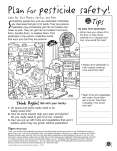 you Qualified fav
Pert Patrol?
Match each pest problem with the least toxic way to attack it.
Then try these ways when you need to pester pests!
Do you know how to prevent each of these pests from becoming a nuisance? Draw a line to
connect each question with the correct answer. Need help? Look throughout this book to find
the answers.
O
You see purple
loosestrife. What do
you do?
Tuck your pant legs into your socks when
walking in tall grass or areas where these
insects may live.
o
How do you keep
roaches out of your
home?
O
Be very still. Don't panic! Just blow at it
gently. It will move.
o
o
What should you do
to avoid tick bites?
How do you keep
mosquitoes from
using your yard to lay
eggs?
O
o
Pull it up right away. Put the pieces in
plastic bags.
J^ Make sure there are no open containers
with water, where these biters can breed.
O
A bee lands on you.
What do you do?
Keep food in closed containers, clean up
crumbs, and take the garbage out every
day.
With the right information and tools, we can solve our
pest problems... /\/\/P be friends to Earth and nature!
TtatV IPMl
•BunoA j&m LUOJJ. ABMV SIVILIIUV Buyons
-pooiq 'Aun deey d/ey yam si&oiiueLjo yo eAiB
siu&id i&oeds miM siseu Jiein du\\ Aeif± ;
esn spJiqBuos jeijio eiuos pu&
Tip for Grown-ups:
For more information on IPM see
www.ipminstitute.org
United States Environmental Protection Agency 2003
image:
you Qualified fav
Pert Patrol?
Match each pest problem with the least toxic way to attack it.
Then try these ways when you need to pester pests!
Do you know how to prevent each of these pests from becoming a nuisance? Draw a line to
connect each question with the correct answer. Need help? Look throughout this book to find
the answers.
O
You see purple
loosestrife. What do
you do?
Tuck your pant legs into your socks when
walking in tall grass or areas where these
insects may live.
o
How do you keep
roaches out of your
home?
O
Be very still. Don't panic! Just blow at it
gently. It will move.
o
o
What should you do
to avoid tick bites?
How do you keep
mosquitoes from
using your yard to lay
eggs?
O
o
Pull it up right away. Put the pieces in
plastic bags.
J^ Make sure there are no open containers
with water, where these biters can breed.
O
A bee lands on you.
What do you do?
Keep food in closed containers, clean up
crumbs, and take the garbage out every
day.
With the right information and tools, we can solve our
pest problems... /\/\/P be friends to Earth and nature!
TtatV IPMl
•BunoA j&m LUOJJ. ABMV SIVILIIUV Buyons
-pooiq 'Aun deey d/ey yam si&oiiueLjo yo eAiB
siu&id i&oeds miM siseu Jiein du\\ Aeif± ;
esn spJiqBuos jeijio eiuos pu&
Tip for Grown-ups:
For more information on IPM see
www.ipminstitute.org
United States Environmental Protection Agency 2003
image:
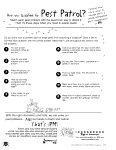 Allergic reaction - Can
include rash, itching, swelling,
sneezing, runny nose, or
trouble breathing due to
contact with things a person is
allergic to.
Bug - General term for insects.
The term "bug" refers to
insects with two pairs of wings
and "beak" mouthparts for
piercing and sucking plant
juices or other insects.
Castings - "Worm poop" that
forms pellets or small piles.
Earthworm castings put
nutrients back into the soil.
Caterpillar - What a moth or
butterfly looks like in the larval
stage of its life cycle.
Compost - A mixture of
organic leftovers that may
include rotted plant materials,
manure, and eggshells. Added
to your garden, it nourishes
the soil and plants.
Insect - An organism with
three body parts (head, thorax,
abdomen) and three pairs of
jointed legs. Most numerous
type of creatures on earth.
Insecticide - A pesticide that
kills insects.
Integrated Pest Management
(IPM) - Choosing among
various ways to treat pest
problems. The goal is to cause
least harm to the environment.
Larva - The second
developmental stage for an
insect that has a four-stage life
cycle: egg, larva, pupa, adult.
Lyme Disease - A flu-like
illness caused by the bite of an
infected deer tick.
Mulch - A layer of material
that gardeners place over the
soil to reduce weeds and hold
moisture.
Native - A plant or animal that
is an original inhabitant of
where you live.
Natural Enemy - Something
existing in nature that kills or
eats an organism.
Nutrients - Substances that
organisms need to live and
grow.
Nymph - A young insect that
has not yet developed into its
adult stage. Nymphs look like
adults but lack fully-formed
wings.
Organism - A living plant or
animal.
Parasite - An organism that
lives off another organism in a
way that harms it.
Pathogen - Something that
causes disease or death in an
organism.
Pest - Something that shows
up where you don't want it.
Examples can include weeds,
insects, mold, rodents, and
bacteria.
Pesticide - A substance used
for keeping pests away, killing
them, or reducing their
numbers. EPA registers — or
licenses — pesticides.
Poison - A substance that
kills, injures, or impairs an
organism through chemical
action.
Predator - An organism that
kills and eats other organisms.
Prey - An animal that another
animal hunts for food.
Spore - A single plant or
animal cell that is able to grow
into a new plant or animal.
Toxic - A word that means
"poisonous in certain
amounts."
Weed - An unwanted plant.
United States Environmental Protection Agency 2003
image:
Allergic reaction - Can
include rash, itching, swelling,
sneezing, runny nose, or
trouble breathing due to
contact with things a person is
allergic to.
Bug - General term for insects.
The term "bug" refers to
insects with two pairs of wings
and "beak" mouthparts for
piercing and sucking plant
juices or other insects.
Castings - "Worm poop" that
forms pellets or small piles.
Earthworm castings put
nutrients back into the soil.
Caterpillar - What a moth or
butterfly looks like in the larval
stage of its life cycle.
Compost - A mixture of
organic leftovers that may
include rotted plant materials,
manure, and eggshells. Added
to your garden, it nourishes
the soil and plants.
Insect - An organism with
three body parts (head, thorax,
abdomen) and three pairs of
jointed legs. Most numerous
type of creatures on earth.
Insecticide - A pesticide that
kills insects.
Integrated Pest Management
(IPM) - Choosing among
various ways to treat pest
problems. The goal is to cause
least harm to the environment.
Larva - The second
developmental stage for an
insect that has a four-stage life
cycle: egg, larva, pupa, adult.
Lyme Disease - A flu-like
illness caused by the bite of an
infected deer tick.
Mulch - A layer of material
that gardeners place over the
soil to reduce weeds and hold
moisture.
Native - A plant or animal that
is an original inhabitant of
where you live.
Natural Enemy - Something
existing in nature that kills or
eats an organism.
Nutrients - Substances that
organisms need to live and
grow.
Nymph - A young insect that
has not yet developed into its
adult stage. Nymphs look like
adults but lack fully-formed
wings.
Organism - A living plant or
animal.
Parasite - An organism that
lives off another organism in a
way that harms it.
Pathogen - Something that
causes disease or death in an
organism.
Pest - Something that shows
up where you don't want it.
Examples can include weeds,
insects, mold, rodents, and
bacteria.
Pesticide - A substance used
for keeping pests away, killing
them, or reducing their
numbers. EPA registers — or
licenses — pesticides.
Poison - A substance that
kills, injures, or impairs an
organism through chemical
action.
Predator - An organism that
kills and eats other organisms.
Prey - An animal that another
animal hunts for food.
Spore - A single plant or
animal cell that is able to grow
into a new plant or animal.
Toxic - A word that means
"poisonous in certain
amounts."
Weed - An unwanted plant.
United States Environmental Protection Agency 2003
image:
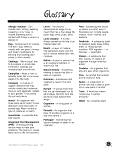 Just for Kids
A Roach Prevention Activity Website for Kids (U.S. Environmental Protection Agency (ERA))
http://www.epa.gov/pesticides/kids/roaches/english/
Backyard Wildlife Habitat Program (National Wildlife Federation)
http://www.nwf.org/backyardwildlifehabitat/
Bugged by Bugs" (Girl Scouts Mile Hi Council)
http://www.buggedbybugs.girlscoutsmilehi.org/
Criteria for Successful Bat Houses (Bat Conservation International)
http://www.batcon.org/bhra/bhcriter.html
Composting for Kids (Texas A & M University)
http://aggie-horticulture.tamu.edu/sustainable/slidesets/kidscompost/cover.html
Green Squad (National Resource Defense Council)
http://www.nrdc.org/greensquad/
Gypsy Moth in North America (USDA Forest Service Northeastern Research Station)
http://www.fs.fed.us/ne/morgantown/4557/gmoth/
Kidzone (The National Wildlife Federation)
http://www.nwf.org/kids/
Thinking Fountain: Dandelion (Science Museum of Minnesota)
http://www.smm.0rg/sln/tf/d/dandelion/dandelion.html
Vermicomposting Kid's Page (National Institute of Environmental Health Sciences, U.S. Department
of Health and Human Services)
http://www.niehs.nih.gov/kids/worms.htm
Who Wants to be an IPM Super Sleuth? (The IPM Institute of North America)
http://www.ipminstitute.org/supersleuth.htm
United States Environmental Protection Agency 2003
image:
Just for Kids
A Roach Prevention Activity Website for Kids (U.S. Environmental Protection Agency (ERA))
http://www.epa.gov/pesticides/kids/roaches/english/
Backyard Wildlife Habitat Program (National Wildlife Federation)
http://www.nwf.org/backyardwildlifehabitat/
Bugged by Bugs" (Girl Scouts Mile Hi Council)
http://www.buggedbybugs.girlscoutsmilehi.org/
Criteria for Successful Bat Houses (Bat Conservation International)
http://www.batcon.org/bhra/bhcriter.html
Composting for Kids (Texas A & M University)
http://aggie-horticulture.tamu.edu/sustainable/slidesets/kidscompost/cover.html
Green Squad (National Resource Defense Council)
http://www.nrdc.org/greensquad/
Gypsy Moth in North America (USDA Forest Service Northeastern Research Station)
http://www.fs.fed.us/ne/morgantown/4557/gmoth/
Kidzone (The National Wildlife Federation)
http://www.nwf.org/kids/
Thinking Fountain: Dandelion (Science Museum of Minnesota)
http://www.smm.0rg/sln/tf/d/dandelion/dandelion.html
Vermicomposting Kid's Page (National Institute of Environmental Health Sciences, U.S. Department
of Health and Human Services)
http://www.niehs.nih.gov/kids/worms.htm
Who Wants to be an IPM Super Sleuth? (The IPM Institute of North America)
http://www.ipminstitute.org/supersleuth.htm
United States Environmental Protection Agency 2003
image:
 For Teachers, Parents, and Other Caregivers
Audubon at Home (National Audubon Society)
http://www.audubon.org/bird/at_home/index.html
Centers for Disease Control and Prevention's Lyme Disease Home Page (Centers for Disease
Control, U.S. Department of Health and Human Services)
http://www.cdc.gov/ncidod/dvbid/lyme/
Citizen's Guide to Pest Control and Pesticide Safety (U.S. Environmental Protection Agency (ERA))
http://www.epa.gov/oppfead1/Publications/Cit_Guide/citguide.pdf
Cooperative State Research, Education, and Extension Service State Partners
(U.S. Department of Agriculture)
http://www.reeusda.gov/1700/statepartners/usa.htm
Green Landscaping: Green Acres (EPA)
http://www.epa.gov/greenacres/
Health Topics A to Z (Centers for Disease Control, U.S. Department
http://www.cdc.gov/health/
How to Use Repellents Safely (EPA)
http://www.epa.gov/pesticides/factsheets/insectrp.htm
Integrated Pest Management in Schools (EPA)
http://www.epa.gov/pesticides/ipm/brochure/index.htm
Mid-Atlantic Region Green Landscaping (EPA - Region 3)
http://www.epa.gov/reg3esd1/garden/index.htm
Outsmarting Poison Ivy and Its Cousins (U.S. Food and Drug Administration)
http://www.fda.gov/fdac/features/796_ivy.html
The American Lyme Disease Foundation (American Lyme Disease Association)
http://www.aldf.com/
Wildlife Invasive Species Team (The Nature Conservancy)
http://tncweeds.ucdavis.edu/
Services)
United States Environmental Protection Agency 2003
image:
For Teachers, Parents, and Other Caregivers
Audubon at Home (National Audubon Society)
http://www.audubon.org/bird/at_home/index.html
Centers for Disease Control and Prevention's Lyme Disease Home Page (Centers for Disease
Control, U.S. Department of Health and Human Services)
http://www.cdc.gov/ncidod/dvbid/lyme/
Citizen's Guide to Pest Control and Pesticide Safety (U.S. Environmental Protection Agency (ERA))
http://www.epa.gov/oppfead1/Publications/Cit_Guide/citguide.pdf
Cooperative State Research, Education, and Extension Service State Partners
(U.S. Department of Agriculture)
http://www.reeusda.gov/1700/statepartners/usa.htm
Green Landscaping: Green Acres (EPA)
http://www.epa.gov/greenacres/
Health Topics A to Z (Centers for Disease Control, U.S. Department
http://www.cdc.gov/health/
How to Use Repellents Safely (EPA)
http://www.epa.gov/pesticides/factsheets/insectrp.htm
Integrated Pest Management in Schools (EPA)
http://www.epa.gov/pesticides/ipm/brochure/index.htm
Mid-Atlantic Region Green Landscaping (EPA - Region 3)
http://www.epa.gov/reg3esd1/garden/index.htm
Outsmarting Poison Ivy and Its Cousins (U.S. Food and Drug Administration)
http://www.fda.gov/fdac/features/796_ivy.html
The American Lyme Disease Foundation (American Lyme Disease Association)
http://www.aldf.com/
Wildlife Invasive Species Team (The Nature Conservancy)
http://tncweeds.ucdavis.edu/
Services)
United States Environmental Protection Agency 2003
image:
 1. How did you find out about this activity book?
1. If you are a teacher, what grade do you teach?
3. What activities did you find most useful and why?
4. Which activities were least useful and why?
5. Do you have any suggestions for additional activities.Web links, or resources that
we might include in a revised activity book?
G. Do you know other people or organizations that might find this book useful?
7. Do you have any other suggestions?
Please send, fax, or e-mail your completed form to:
Kathy Seikel, Office of Pesticide Programs
U.S. Environmental Protection Agency
1200 Pennsylvania Ave., NW (7506C)
Fax: (703) 308-5558
seikel.kathy@epa.gov
Thanks for your comments!!
United States Environmental Protection Agency 2003
image:
1. How did you find out about this activity book?
1. If you are a teacher, what grade do you teach?
3. What activities did you find most useful and why?
4. Which activities were least useful and why?
5. Do you have any suggestions for additional activities.Web links, or resources that
we might include in a revised activity book?
G. Do you know other people or organizations that might find this book useful?
7. Do you have any other suggestions?
Please send, fax, or e-mail your completed form to:
Kathy Seikel, Office of Pesticide Programs
U.S. Environmental Protection Agency
1200 Pennsylvania Ave., NW (7506C)
Fax: (703) 308-5558
seikel.kathy@epa.gov
Thanks for your comments!!
United States Environmental Protection Agency 2003
image:
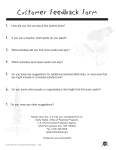 PESTS OR GUESTS, p. 1
1. P, grub 5. G, spider
2. P, worm 6. P, mosquito
3. G, bee 7. P, ants
4. P, cockroach 8. P, wasp
INSECT PESTS AND PALS, p. 2
THE 3 P'S IN ACTION, p. 3
1. parasite
2. pathogen
3. predators
GREEN. GREEN GRASS, p. 6
1. Grass needs nothing.
2. fertilizer
3. nothing
4. fertilizer
PURPLE PLAGUE, p. 8
Florida, Hawaii
BEWARE, p. 9
Milfoil
OUTSMART THOSE PESTS, p. 10
1. birdhouses, sunflowers
2. toads, slugs
3. garbage
4. crumbs
5. screens
6. tomatoes
MAZE, p. 11
Pests can get into any opened or spilled
containers.
COCKROACH MENU, p. 12
(FOIIBTGBRHAID[ILOD[E[PIB[IIIHfGH)D
PHEfflH OIIHWGUGDUYDHHIE[TD
UH D OW EQ ¥ D [
S H E N fl
QCC H N D B N IE D ]
UEDBHDWBHXQUI
OHBQEHOBQYUOl
UWEEmSHEOEHlHWEIi:
z H ia MB E T] F Q <s mpB E M ID i
EEH]
PQDQHHfflTaDBA
MOSQUITO-EATING
MACHINES, p. 15
3,000 and 7,000 mosquitoes
WHAT'S ALL THE BUZZZ?. p. 17
A. wasp
B.honeybee
GYPSY MOTH, p. 18
l.oak A. 2
2. aspen B. 4
3. poplar C. 1
4. apple D. 3
5. crabapple
6. birch
7. maple
8. willow
9. basswood
10. box elder
CRAZY ABOUT COMPOST, p. 20
Good soil.
COMPOST INGREDIENTS, p. 21
A. coffee grounds
B. grass clippings
C. food scraps
D. decaying leaves
E. veggie peels
F. eggshells
G. fruit cores
ARE YOU QUALIFIED FOR
PEST PATROL?, p. 24
1.C
2. E
3. A
4. D
5. B
image:
PESTS OR GUESTS, p. 1
1. P, grub 5. G, spider
2. P, worm 6. P, mosquito
3. G, bee 7. P, ants
4. P, cockroach 8. P, wasp
INSECT PESTS AND PALS, p. 2
THE 3 P'S IN ACTION, p. 3
1. parasite
2. pathogen
3. predators
GREEN. GREEN GRASS, p. 6
1. Grass needs nothing.
2. fertilizer
3. nothing
4. fertilizer
PURPLE PLAGUE, p. 8
Florida, Hawaii
BEWARE, p. 9
Milfoil
OUTSMART THOSE PESTS, p. 10
1. birdhouses, sunflowers
2. toads, slugs
3. garbage
4. crumbs
5. screens
6. tomatoes
MAZE, p. 11
Pests can get into any opened or spilled
containers.
COCKROACH MENU, p. 12
(FOIIBTGBRHAID[ILOD[E[PIB[IIIHfGH)D
PHEfflH OIIHWGUGDUYDHHIE[TD
UH D OW EQ ¥ D [
S H E N fl
QCC H N D B N IE D ]
UEDBHDWBHXQUI
OHBQEHOBQYUOl
UWEEmSHEOEHlHWEIi:
z H ia MB E T] F Q <s mpB E M ID i
EEH]
PQDQHHfflTaDBA
MOSQUITO-EATING
MACHINES, p. 15
3,000 and 7,000 mosquitoes
WHAT'S ALL THE BUZZZ?. p. 17
A. wasp
B.honeybee
GYPSY MOTH, p. 18
l.oak A. 2
2. aspen B. 4
3. poplar C. 1
4. apple D. 3
5. crabapple
6. birch
7. maple
8. willow
9. basswood
10. box elder
CRAZY ABOUT COMPOST, p. 20
Good soil.
COMPOST INGREDIENTS, p. 21
A. coffee grounds
B. grass clippings
C. food scraps
D. decaying leaves
E. veggie peels
F. eggshells
G. fruit cores
ARE YOU QUALIFIED FOR
PEST PATROL?, p. 24
1.C
2. E
3. A
4. D
5. B
image:
